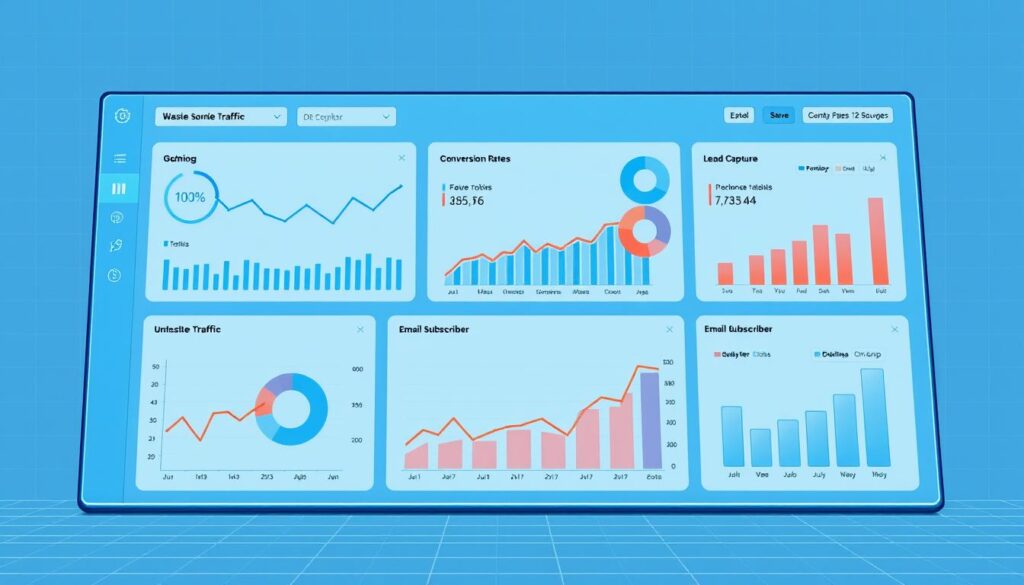Are you finding it hard to get new customers for your SaaS startup? You're not alone. Most marketers say getting good leads is their biggest goal, but it's tough.
Effective lead generation is key to growing your business. In today's digital world, using the right tactics to find your audience is vital.
Here are the top 5 ways to beat the lead generation challenge and move your startup forward. These strategies will help you draw in, keep, and turn good leads into customers.
 As a startup, knowing the difference between lead generation and demand generation is vital. They are both important for your b2b lead generation strategy. Yet, they have different roles and are used at different times.
As a startup, knowing the difference between lead generation and demand generation is vital. They are both important for your b2b lead generation strategy. Yet, they have different roles and are used at different times.
 In today's market, a multichannel outreach strategy is key for lead generation. Startups need to meet their customers where they are. This means being active on many marketing channels.
A multichannel strategy helps you reach your audience through different ways. This boosts your chances of converting leads. By using email, LinkedIn, and cold advertising, you can build a strong lead generation system.
In today's market, a multichannel outreach strategy is key for lead generation. Startups need to meet their customers where they are. This means being active on many marketing channels.
A multichannel strategy helps you reach your audience through different ways. This boosts your chances of converting leads. By using email, LinkedIn, and cold advertising, you can build a strong lead generation system.
With a well-coordinated multichannel strategy, you can improve your lead generation. This can help your business grow.
By matching your content with your product's features and use cases, you create a strong content marketing plan. This plan will speak to your target audience.
 SaaS startups can grow faster by using paid demand generation channels wisely. These channels are key for getting high-quality leads and boosting conversions. By choosing the right channels, you can reach your audience better and grow your business quicker.
SaaS startups can grow faster by using paid demand generation channels wisely. These channels are key for getting high-quality leads and boosting conversions. By choosing the right channels, you can reach your audience better and grow your business quicker.
 To see how well your online lead generation is doing, you need to track the right metrics. Knowing what works and what doesn't helps you make better choices. This way, you can improve your digital marketing strategy.
To see how well your online lead generation is doing, you need to track the right metrics. Knowing what works and what doesn't helps you make better choices. This way, you can improve your digital marketing strategy.
Key Takeaways
- Understand the importance of lead generation for early-stage SaaS startups
- Learn the top 5 lead generation tactics to drive growth
- Discover how to attract, engage, and convert high-quality leads
- Implement effective digital marketing strategies to reach your target audience
- Overcome common lead generation challenges and achieve success
Why Lead Generation Is Critical for Early-Stage SaaS Startups
In the competitive world of SaaS, getting leads is key for startups to grow. You know how hard it is to get your first customers and keep a steady flow of leads.The Customer Acquisition Challenge for New Businesses
Getting customers is a big challenge for new SaaS companies. 87% of prospects say salespeople don't understand their problems. This shows the need for a deeper approach to getting leads. You must know what your target audience needs and adjust your marketing to meet those needs.How Effective Lead Generation Impacts Growth Metrics
Good lead generation boosts your growth by bringing more people into your sales funnel. By focusing on demand generation and SaaS product marketing, you can attract more qualified leads. This leads to better conversion rates and more revenue.Setting Realistic Lead Generation Goals
To do well in lead generation, set goals that match your growth stage and market. Know your customer acquisition costs, customer lifetime value, and conversion rates at each sales funnel stage. Setting reachable goals helps you plan your lead generation and measure success.Lead Generation vs. Demand Generation: Understanding the Difference
 As a startup, knowing the difference between lead generation and demand generation is vital. They are both important for your b2b lead generation strategy. Yet, they have different roles and are used at different times.
As a startup, knowing the difference between lead generation and demand generation is vital. They are both important for your b2b lead generation strategy. Yet, they have different roles and are used at different times.
Defining Both Approaches
Lead generation aims to get the interest of possible customers and turn them into leads. It uses targeted campaigns to get their contact info for something valuable, like a whitepaper or webinar. Demand generation is a wider strategy. It aims to make people aware of and interested in your product or service. It includes content marketing, social media, and ads to boost demand and revenue.When to Focus on Each Strategy
Choosing between lead generation and demand generation depends on your goals and where you are in your marketing. For a new product, demand generation might be best to start the buzz. For an established product, lead generation can help convert interested people."Demand generation is about creating a market for your product or service, while lead generation is about capturing and converting the interest generated." - Marketing Expert
| Strategy | Primary Goal | Tactics |
|---|---|---|
| Lead Generation | Capture and convert interest | Targeted campaigns, landing pages, lead magnets |
| Demand Generation | Create awareness and stimulate demand | Content marketing, social media, advertising |
How They Work Together in Your Marketing Funnel
Lead generation and demand generation are not separate; they work together. Demand generation starts by making people aware. Then, lead generation captures that interest and turns it into real leads. By understanding and using both strategies well, you can make a strong multichannel marketing plan. This plan will connect with your audience and increase conversions.Building a High-Converting Website Funnel
Your website is often the first point of contact with customers. It's key to optimize it for lead generation. A well-designed website funnel can greatly improve your startup's lead capture and conversion.SEO Fundamentals for Startup Websites
To draw in organic traffic, your site must be search engine-friendly. Start with keyword research to find terms your audience uses. Make sure your content is high-quality, engaging, and informative, adding value to visitors. Don't forget about technical SEO. Your site should load fast, be mobile-friendly, and have HTTPS. These improve user experience and search rankings.Conversion Rate Optimization Best Practices
Conversion Rate Optimization (CRO) boosts the number of visitors who become leads or customers. Understanding your audience's behavior and preferences is key.Strategic CTA Placement
Calls-to-Action (CTAs) guide visitors toward actions. Place them strategically on busy pages and after engaging content. Use contrasting colors and clear, actionable text for your CTAs. For example, "Sign Up Now" or "Get Started" buttons work better than "Submit".Form Optimization Techniques
Forms are vital for capturing leads. Keep them short and simple, asking only for necessary info. A long form can scare off visitors. Try progressive profiling by asking for more info as visitors engage more. This builds a detailed lead profile without overwhelming them. By using these strategies, you can boost your website's lead generation and conversion. Focus on a smooth user experience. Keep testing and refining your website funnel for the best results.Developing a Multichannel Outreach Strategy
 In today's market, a multichannel outreach strategy is key for lead generation. Startups need to meet their customers where they are. This means being active on many marketing channels.
A multichannel strategy helps you reach your audience through different ways. This boosts your chances of converting leads. By using email, LinkedIn, and cold advertising, you can build a strong lead generation system.
In today's market, a multichannel outreach strategy is key for lead generation. Startups need to meet their customers where they are. This means being active on many marketing channels.
A multichannel strategy helps you reach your audience through different ways. This boosts your chances of converting leads. By using email, LinkedIn, and cold advertising, you can build a strong lead generation system.
Combining Email, LinkedIn, and Cold Advertising
Each channel has its own strengths. Email lets you send personalized messages. LinkedIn is great for B2B outreach. Cold advertising helps you reach more people. Combining these channels makes your marketing strategy more effective. For example, use LinkedIn to find leads and then send them targeted emails. Cold advertising can bring people to your website. There, you can capture leads with well-designed landing pages.Personalization Frameworks That Drive Response Rates
Personalization is essential for better response rates. Tailor your messages to meet your audience's needs. This boosts engagement and conversion rates.Timing and Frequency Guidelines
The timing and frequency of your outreach matter a lot. You want to stay in touch without overwhelming your leads.- Space out your emails to avoid flooding leads.
- Use LinkedIn messaging for more personalized follow-ups.
- Monitor ad performance to adjust your cold advertising strategy.
Cross-Channel Coordination
It's important to coordinate your efforts across channels for a smooth customer experience. Make sure your messages are consistent across all touchpoints. Also, track the customer journey well.| Channel | Purpose | Frequency |
|---|---|---|
| Nurturing leads | Bi-weekly | |
| Personalized follow-ups | As needed | |
| Cold Advertising | Awareness and traffic | Continuous |
Content Marketing for SaaS Product Education
Content marketing is key for SaaS product education. It helps businesses reach their audience. By making valuable content, you teach people about your product and its benefits. This can lead to more sales.Creating Content That Addresses Buyer Pain Points
To really teach your audience, you must tackle their problems. Know what they struggle with and offer solutions in your content.Blog Content Strategy
Having a solid blog plan is vital for SaaS education. Make sure your blog posts are full of useful information for your readers.Webinar and Video Content
Webinars and videos are also great for teaching your audience. They offer a chance for more interactive and engaging content. This builds trust with your future customers.Aligning Content with Product Features and Use Cases
It's important to match your content with your product's features and how it's used. This makes sure your content is both relevant and useful to your audience. Here's how you can match your content with your product's features:| Product Feature | Content Type | Use Case |
|---|---|---|
| Advanced Analytics | Blog Post | Explaining how advanced analytics can improve business decision-making |
| User-Friendly Interface | Video Tutorial | Demonstrating how to navigate the product's interface |
| Integration Capabilities | Webinar | Showcasing how the product integrates with other tools and platforms |
Leveraging Paid Demand Generation Channels
 SaaS startups can grow faster by using paid demand generation channels wisely. These channels are key for getting high-quality leads and boosting conversions. By choosing the right channels, you can reach your audience better and grow your business quicker.
SaaS startups can grow faster by using paid demand generation channels wisely. These channels are key for getting high-quality leads and boosting conversions. By choosing the right channels, you can reach your audience better and grow your business quicker.
Google Ads Strategy for SaaS Startups
Google Ads is a strong tool for SaaS startups. Focus on long-tail keywords that match your product or service. This targets users closer to buying, increasing your chances of success. Also, use negative keywords to block unwanted traffic and save on ads. Make sure your ad copy speaks to your audience. Highlight what makes your SaaS product special. Use ad extensions to give more details and boost clicks.LinkedIn Advertising Tactics
LinkedIn is great for B2B lead generation. To make the most of LinkedIn Ads, target specific job titles, industries, and company sizes. This helps you reach key decision-makers in your market. Use sponsored content and sponsored InMail for personalized messages.Retargeting Campaigns That Convert
Retargeting campaigns are vital for bringing back users who've visited but not converted. With retargeting ads, you keep your brand in mind and encourage returns. Make sure your ads are relevant to their past site interactions.Budget Allocation and Message Matching
Effective budgeting is key in paid demand generation. Spend your budget based on channel and campaign performance. Keep your messaging consistent across all platforms and match your brand's marketing strategy. Match your message to what users need and want for better engagement and conversions. Use data-driven insights to improve your messaging and campaign performance.Automating Lead Nurturing with Marketing Workflows
To boost your inbound marketing, think about using marketing workflows to automate lead nurturing. This method helps streamline your sales process, boosts conversion rates, and grows your business. It lets you handle repetitive tasks and focus on important, personal work.Building Effective Email Sequences
Creating effective email sequences is key to automating lead nurturing. These sequences engage leads with relevant info at the right time. To make a good email sequence, know your audience's needs and likes. Personalization is key; use data to make your messages more engaging. Start with a welcome email that introduces your brand and offers value. Then, send more emails that dive into specific topics or product features. Timing is everything; space out your emails to keep leads interested without feeling bombarded.Implementing Lead Scoring Systems
Lead scoring systems are also important for automated lead nurturing. They score leads based on their actions, demographics, and other factors. This score helps you know when to pass leads to the sales team. Accurate lead scoring is key for focusing your sales team on the best leads. To set up a good lead scoring system, decide what actions will score leads. This could be downloading a whitepaper, attending a webinar, or visiting certain website pages. Assign points to these actions to create a scoring model that shows a lead's engagement and readiness to buy.Creating Behavior-Based Triggers
Behavior-based triggers are vital for automating lead nurturing. These triggers are actions by leads that prompt a response from your marketing system. By setting up these triggers, you ensure leads get timely, relevant communications.Website Activity Triggers
Website activity triggers are based on how leads interact with your site. For example, if a lead keeps visiting a product page, send an email with more info or a special offer. Monitoring website activity lets you respond when leads are most engaged.Content Engagement Triggers
Content engagement triggers track how leads interact with your content. This could be downloading an e-book, watching a video, or reading your blog. By tracking these interactions, you can send personalized follow-ups that build on their interest."The key to successful lead nurturing is understanding your audience's behavior and preferences, and using that information to deliver personalized, timely communications."By automating lead nurturing with marketing workflows, you can offer personalized communications and enhance your lead generation strategies.
Measuring Your Lead Generation Success
 To see how well your online lead generation is doing, you need to track the right metrics. Knowing what works and what doesn't helps you make better choices. This way, you can improve your digital marketing strategy.
To see how well your online lead generation is doing, you need to track the right metrics. Knowing what works and what doesn't helps you make better choices. This way, you can improve your digital marketing strategy.
Key Performance Indicators for Lead Generation
Key performance indicators (KPIs) are measurable signs of success in lead generation. Important KPIs include:- Conversion rates
- Lead volume
- Cost per lead
- Lead quality
Attribution Models for Startup Marketing
Attribution models show how different marketing channels help with lead generation. Common models are:- First-touch attribution
- Last-touch attribution
- Multi-touch attribution
Reporting Frameworks That Drive Decision-Making
A good reporting framework is key to making smart decisions. It involves:- Regularly reviewing your KPIs
- Analyzing your attribution models
- Adjusting your marketing strategy based on your findings
Common Lead Generation Mistakes Startups Should Avoid
Startups face many challenges in lead generation, but knowing the pitfalls is key. Understanding these mistakes can help you avoid them. This is important in SaaS product marketing and multichannel marketing.Targeting Too Broad an Audience
One big mistake is targeting too many people. This can waste a lot of resources on leads that aren't a good fit. Instead, focus on a specific group that really needs your product.Neglecting the Middle of the Funnel
Startups often ignore the middle of the sales funnel. This can leave leads without the nurturing they need. Make sure to offer valuable content and engagement at every stage.Failing to Align Sales and Marketing Teams
When sales and marketing teams don't work together, it can hurt your business. Regular talks and shared goals can help them work better together.Inconsistent Follow-Up Processes
Following up in a consistent way is critical. It can turn a lead into a customer. Make sure you have a solid follow-up plan in place.| Mistake | Impact | Solution |
|---|---|---|
| Targeting too broad an audience | Wasted resources on unqualified leads | Focus on a specific niche |
| Neglecting the middle of the funnel | Lack of nurturing for leads | Provide valuable content at every stage |
| Failing to align sales and marketing teams | Disjointed customer experience | Regular communication and shared goals |
| Inconsistent follow-up processes | Missed opportunities | Implement consistent follow-up |
Conclusion: Optimizing and Scaling Your Lead Generation System
You now know how vital lead generation is for your SaaS startup's growth. To improve and grow your lead generation, focus on making your outreach better and automating nurturing with marketing workflows. Keep track of your lead generation success by watching key performance indicators and attribution models. This helps you make smart choices to boost your lead generation. Avoid common mistakes like targeting too wide an audience and ignoring the middle of the funnel. Work closely with your sales and marketing teams and use consistent follow-ups to increase your lead generation. By combining lead generation and demand generation, you can build a strong marketing funnel. Focus on creating valuable content that solves buyer problems and fits your product's features and use cases.FAQ
What is the primary challenge faced by early-stage SaaS startups in generating leads?
Early-stage SaaS startups face a big challenge. They struggle to get customers and quality leads. This is because they have little brand awareness and resources.
How does effective lead generation impact the growth metrics of SaaS startups?
Good lead generation boosts SaaS startups' growth. It increases the number of good leads, conversion rates, and revenue.
What is the difference between lead generation and demand generation?
Lead generation is about getting and nurturing leads. Demand generation is about making people interested in your product or service.
How can I build a high-converting website funnel for my SaaS startup?
To make a great website funnel, focus on SEO and conversion rate optimization. Also, place CTAs strategically to boost conversions.
What is the benefit of developing a multichannel outreach strategy for lead generation?
A multichannel strategy combines email, LinkedIn, and cold ads. It uses personalization to get more responses and leads.
How can content marketing help educate my SaaS product's future customers?
Content marketing educates by addressing buyer pain points. It aligns with your product's features and use cases.
What are the benefits of leveraging paid demand generation channels?
Paid channels like Google Ads and LinkedIn Ads boost brand awareness. They drive traffic and generate leads.
How can I automate lead nurturing with marketing workflows?
Automate lead nurturing with email sequences and lead scoring. Use behavior-based triggers to nurture leads.
What are the key performance indicators (KPIs) for measuring lead generation success?
KPIs include lead volume, conversion rates, cost per lead, and ROI. These metrics measure lead generation success.
What are common lead generation mistakes that startups should avoid?
Avoid targeting too wide an audience and neglecting the middle funnel. Also, don't fail to align sales and marketing, and be consistent in follow-up.
How can I optimize and scale my lead generation system?
To optimize and scale, track key metrics and use attribution models. Create reporting frameworks for better decision-making.
What is the role of attribution models in lead generation?
Attribution models show the impact of marketing channels on lead generation. They help optimize your marketing mix.
How can I ensure alignment between sales and marketing teams for effective lead generation?
Ensure alignment by setting up clear communication channels. Define common goals and have processes for feedback and lead qualification.
